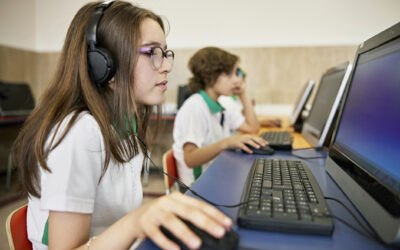Districts often have Instructional Technology specialists that can assist teachers who are interested, but their time is limited. How can teachers empower themselves to understand their options when it comes to professional development for technology integration, and how can they seek support and advice from a community both inside and outside their district?
Stop Learning Backwards
While teachers try to play catch-up in the edtech world, districts need to be more flexible and realistic in their commitment to helping staff and leadership learn. One way to improve is to explore emerging technologies that can have a positive impact on learning and increase student engagement. Mastering every single technology popular in education now isn’t the solution–realistically, those technologies may become obsolete. Instead, the solution is empowering staff to know how to find professional development for technology integration and the best places to continue learning, connect, and build their professional learning community.
Educators, both new and veteran, can expand on their own skills/interests, whether it’s connecting on Twitter, being given the opportunity to present to colleagues via staff meetings, or attending professional development opportunities or conferences. There are also opportunities for professional development through YouTube, podcasts, and online communities and forums that can supplement, if not replace, traditional methods of professional development. With personalized options, individuals can differentiate themselves based on their personal interest, curriculum needs and ability level.
These are just some of the creative ways that teachers can build their own custom professional development for technology suited to their learning styles and needs. If the desire exists to be a lifelong learner, then there are opportunities everywhere.
Do as I Say…AND as I Do
Practice what you preach. Professors, trainers and professional development specialists should take a lesson from a teacher’s handbook and design learning to mirror the way teachers are expected to teach. Forcing teachers to sit, listen and take notes during professional development while the sage on the stage talks at them is completely opposite of what’s expected daily of them in their classroom with their own learners. Just as kids will instinctually mimic what they see and hear, so will teachers. If we want to break the cycle of the traditional lecture, we have to break the mold on how teaching and learning is modeled when teachers are put in the position of students.
Not Afraid to Try
Teachers need opportunities to practice LIVE implementation–and to feel empowered to do so. Leadership should encourage a growth mindset by giving opportunities such as staff meetings and team-building time to utilize a technology integration experience. Teachers should have access to an authentic and safe setting in which they may receive suggestions and feedback. This forces the refinement and reflection process in a very low-risk environment that will allow for improvement before students experience it in the classroom.
If the Ship Doesn’t Sail THEN ROW
Even if individual teachers are self-motivated and eager to implement, there is still a chance that the district does not yet have the tools or people in place to utilize educational technology. What then? What can teachers do to help make “it” possible for their school? ROW! Do something. Be the change agent. Someone must if things will ever change. Connect with another school who is doing technology integration well. Find opportunities through grants, PTOs, local businesses for professional development and resources. Be relentless in doing what you know is best for student learning and preparing them for the future outside your classroom.
This article was originally published in August, 2019, and has been updated.

Learning.com Team
Staff Writers
Founded in 1999, Learning.com provides educators with solutions to prepare their students with critical digital skills. Our web-based curriculum for grades K-12 engages students as they learn keyboarding, online safety, applied productivity tools, computational thinking, coding and more.
Further Reading
Understanding Proclamation 2024 and the TA-TEKS
Understanding Proclamation 2024 and the TA-TEKS In 2024, Texas introduced Proclamation 2024 to begin the process of adopting new instructional...
Guide to Teaching Algorithms in Computer Programming for K-12 Students
Algorithms are the heart of computer programming, providing the step-by-step instructions that computers follow to perform tasks and solve problems....
Planning Digital Literacy Assessment: A Simplified Approach
As educators know, assessments are critical to the learning process. They provide beneficial self-checks to students, informative results to...




